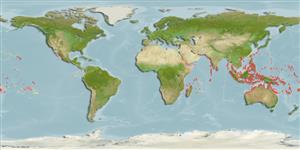>
Ovalentaria/misc (Various families in series Ovalentaria) >
Pomacentridae (Damselfishes) > Pomacentrinae
Etymology: Chrysiptera: Greek, chrysos = golden + Greek, pteron = fin, wing (Ref. 45335).
More on authors: Quoy & Gaimard.
Environment: milieu / climate zone / depth range / distribution range
Ecologia
marino associati a barriera corallina; non migratori; distribuzione batimetrica 0 - 5 m (Ref. 7247). Tropical; 30°N - 23°S
Indo-Pacific: East Africa to the Marshall and Gilbert islands and Samoa, north to the Ryukyu Islands, south to Australia.
Size / Peso / Age
Maturity: Lm ? range ? - ? cm
Max length : 12.5 cm TL maschio/sesso non determinato; (Ref. 48600)
Short description
Chiavi di identificazione | Morfologia | Morfometria
Spine dorsali (totale) : 13; Raggi dorsali molli (totale) : 12 - 14; Spine anali: 2; Raggi anali molli: 13 - 14. Bluish or purplish spots at the posterior base of the dorsal fin. Juveniles with large ocellus that reduces with size and lacks completely in adults. The white band in young reduces to a small white saddle in large adults (Ref. 48636). Body depth 2.2-2.5 in SL (Ref. 90102).
Adults occur in protected inner reef flats and shallow lagoons and channels, over rubble and rocky outcrops. Feed primarily on filamentous algae (Ref. 7247). Oviparous, distinct pairing during breeding (Ref. 205). Eggs are demersal and adhere to the substrate (Ref. 205). Males guard and aerate the eggs (Ref. 205). Diurnal species (Ref. 54980; 113699).
Life cycle and mating behavior
Maturities | Riproduzione | Spawnings | Egg(s) | Fecundities | Larve
Oviparous, distinct pairing during breeding (Ref. 205). Eggs are deposited inside empty shells or under stones or shells (Ref. 36479). Males guard and aerate the eggs (Ref. 205).
Allen, G.R., 1991. Damselfishes of the world. Mergus Publishers, Melle, Germany. 271 p. (Ref. 7247)
IUCN Red List Status (Ref. 130435)
Threat to humans
Harmless
Human uses
Warning: mysqli::__construct(): (HY000/1040): Too many connections in /var/www/html/includes/func_getlabel.php on line 46
Can't connect to MySQL database (fbapp). Errorcode: Too many connections
